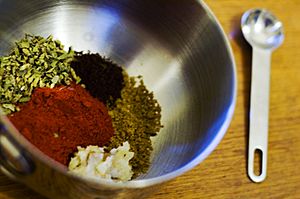Seasoning facts for kids
Seasoning is when you add special ingredients like salt, herbs, or spices to food. It's done to make the food taste much better and more interesting! Think of it as giving your meal a flavor boost. People all over the world have many different ways of adding seasoning. For example, in some places, people might pour a tasty sauce over their dish right before they eat it.
Contents
Why Season Food?
Adding seasoning to food does more than just make it taste good. Here are some main reasons why we season our meals:
- Making it Delicious: The most important reason is to improve the flavor. Seasonings can make bland food exciting and bring out the natural tastes of ingredients.
- Adding Aroma: Many spices and herbs have wonderful smells. These aromas make the food more appealing even before you take a bite.
- Changing Color: Some seasonings, like paprika or turmeric, can add beautiful colors to your dishes, making them look more appetizing.
- Preserving Food: Long ago, before refrigerators, salt and some spices were used to help keep food from spoiling quickly. This was a very important way to store food for a long time.
What Are Common Seasonings?
There are thousands of different seasonings used around the globe. Here are some of the most common types:
Salt
Salt is probably the most basic and widely used seasoning. It doesn't just make food salty; it actually helps to bring out and enhance the natural flavors of other ingredients. There are many kinds of salt, like sea salt, table salt, and Himalayan pink salt. Each can add a slightly different touch to your food.
Herbs
Herbs usually come from the leaves of plants. They can be used fresh or dried.
- Fresh Herbs: These often have a stronger, brighter flavor. Examples include parsley, basil, mint, and cilantro. They are great for adding at the end of cooking or as a garnish.
- Dried Herbs: These are herbs that have been dried, which makes their flavor more concentrated. Common dried herbs are oregano, thyme, and rosemary. They are often added during the cooking process.
Spices
Spices come from other parts of plants besides the leaves, like seeds, bark, roots, or fruits. They are usually dried and often ground into a powder.
- Common Spices: Some popular spices include black pepper (from berries), cinnamon (from bark), ginger (from a root), and cumin (from seeds).
- Spice Blends: Many cultures use mixtures of different spices to create unique flavors. Examples include curry powder, chili powder, and garam masala. These blends make it easy to add complex flavors to dishes.
Condiments and Sauces
Sometimes, seasonings are added after the food is cooked, often at the table. These are called condiments or sauces.
- Condiments: These include things like ketchup, mustard, soy sauce, and hot sauce. They let each person adjust the flavor of their meal to their liking.
- Sauces: Many dishes are served with a sauce that has been seasoned during its preparation. These sauces can add moisture, richness, and a burst of flavor to the main dish.
Seasoning Around the World
Every culture has its own special ways of seasoning food, often using ingredients that grow locally.
- Asian Cuisine: In many Asian countries, ingredients like soy sauce, ginger, garlic, and chili peppers are very common. For example, in India, complex spice blends like curry are central to many dishes.
- Mexican Cuisine: Mexico is famous for using chili peppers (like jalapeños and chipotles), cumin, oregano, and cilantro to create bold and vibrant flavors.
- Italian Cuisine: Italy often uses simple, fresh ingredients like basil, oregano, garlic, and olive oil to highlight the natural taste of food.
- Middle Eastern Cuisine: Spices like cumin, coriander, paprika, and mint are frequently used in Middle Eastern cooking, often in dishes like stews and grilled meats.
Learning about different seasonings is a fun way to explore cultures through food!
Related pages
Images for kids




